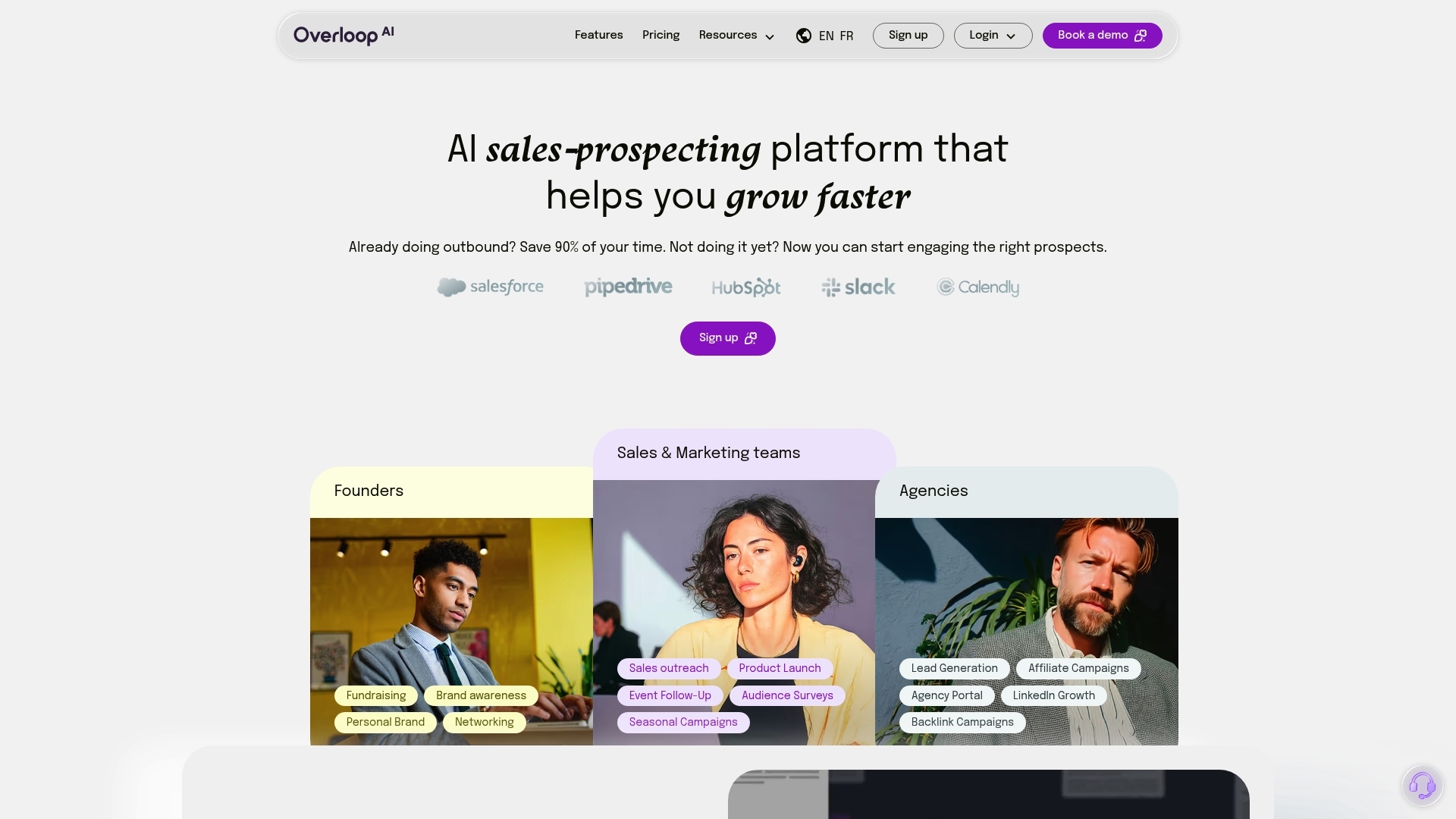Cold emails continue to play a key role in B2B sales because they open doors to new business relationships and steady streams of leads. These messages can connect companies that might never cross paths and spark valuable conversations with decision makers. Whether you are aiming to reach a potential client, partner, or stakeholder, an effective cold email gets your offer in front of the right people without waiting for inbound interest.
Many B2B sales teams rely on email outreach because it gives them direct control over their pipeline. Unlike methods like paid ads or social media, cold emails do not depend on algorithms or audiences that you do not own. With the right strategy, you can consistently generate outbound leads, share your value in a clear way, and start meaningful interactions that drive growth.
Tools such as Overloop help teams outperform manual efforts by automating prospect research and scaling personalized outreach. By reducing the amount of repetitive work, you spend more time on conversations that matter and less time on admin tasks. In the sections below, you will find practical steps for making cold emails work, from understanding what drives strong performance to tracking your campaign success.
Understanding the Foundations of Effective Cold Emails
Cold emails remain an essential tool for B2B sales teams, but true effectiveness starts with understanding four cornerstones: clear objectives, precise audience insights, value-driven messaging, and smart personalization. When these are in place, each email has a greater chance of reaching its recipient and inspiring action.
Setting Clear Goals from the Start
Every successful cold email campaign begins by defining its goals. Are you introducing your company, booking a product demo, or aiming for a short feedback call? Precise objectives help tailor subject lines, structure messaging, and measure outcomes later. Vague or unfocused goals confuse recipients and reduce reply rates. Decide in advance what success looks like for your outreach, such as securing a response, a meeting, or simply delivering brand awareness to the right contact.
Knowing Your Target Audience
Effective cold emails rely on relevant audience targeting. This means more than just job titles. It involves:
- Identifying companies that match your ideal customer profile
- Researching buyer intent and recent activities (such as new funding, product launches, or key hires)
- Understanding decision-maker pain points unique to their company or sector
Advanced tools can speed up this stage. Overloop, for example, combines a large B2B database and AI-based filters, so users can focus their campaigns on promising segments rather than casting a wide net.
Creating Value-Driven Messaging
Recipients need a reason to read and respond. Instead of talking about your product features, focus on challenges your prospect faces and how your solution can help. Deliver specific, relevant value in the body of your email. A value-driven message addresses a clear pain point, relates directly to the reader's role, and suggests a logical next step. Provide proof if available, such as results from other companies in the same sector. For inspiring examples of proven outcomes, you can review B2B success stories.
Personalization that Feels Genuine
Personalization goes beyond just addressing someone by name. Reference details that show genuine research, such as a recent company development or industry trend relevant to their business. Even minimal custom touches can demonstrate credibility and raise the chance of a response. AI-powered sales tools streamline this process at scale without losing the impact of a human touch.
By applying these foundational principles, every cold email campaign has stronger relevance, clarity, and persuasiveness, securing a better return on effort for sales teams.
Crafting Compelling Subject Lines to Maximize Open Rates
Once you have identified your target audience and crafted a message that delivers value, the subject line becomes your first and sometimes only chance to capture a prospect’s attention. Recipients often judge whether to open an email solely on those few words, making this element critical to the success of your outreach.
Essentials of a High-Performing Subject Line
The most effective subject lines have a few things in common:
- Brevity: Keep it under 50 characters so it displays fully on mobile devices and busy inboxes.
- Clarity: Communicate what the email is about without being vague or clever for its own sake.
- Relevance: Use language or details that relate directly to the recipient, such as their role, company, or a recognizable pain point.
Attention-Grabbing Techniques That Work
Proven tactics to boost open rates include:
- Direct value (“Quick idea for scaling [Company Name]”)
- Personalization (insert a first name, industry, or recent achievement)
- Question format (“Are you targeting new markets in 2024?”)
- Data points or specific results (“How X company increased responses by 50%”)
- Step away from clickbait or overused claims (like “You won’t believe this offer”)
Test your subject lines regularly since what works can shift based on audience and timing. Using A/B testing, compare variations to identify which style connects best with your segment. Open rates alone do not guarantee leads, but they are the anchor of every effective cold email campaign.
Using Overloop for Optimized Subject Lines
Platforms like Overloop use AI insights and automation so that subject lines reflect recipient data and stay outcome-focused. Their tools allow you to personalize at scale and adjust your approach based on campaign analytics, which improves visibility and open performance without manual subject line crafting for each message. Learn more about key capabilities by checking Overloop’s feature overview.
The goal is always to be concise, honest, and relevant, prompting the recipient’s interest just enough to move from the inbox to the message content itself.
Personalization Techniques That Drive Engagement
Personalization drives results in cold outreach because it signals effort, research, and intent. Instead of generic templates, useful personalization starts with basic details and extends to business context that shows recognition of the recipient’s unique challenges. The right approach increases reply rates and demonstrates respect for your prospect’s time and priorities.
Move Past Basic Name Insertion
Simply using someone’s name is no longer enough to stand out. Combining the recipient’s name with a relevant detail forms a stronger opening. For example, referencing the recipient’s recent accomplishment or mentioning a shared connection immediately makes the exchange feel more authentic.
- Mention the company’s latest news, product launch, or market move
- Reference a published quote, report, or case study featuring the recipient
- Show awareness of industry changes affecting their team
Starting with a specific reference provides immediate context and creates the impression that your email was composed intentionally, not through automation.
Use Targeted Business Insights
A cold email feels relevant when it solves a current problem for the recipient’s organization. This means thoughtfully considering:
- How your product can address their exact challenges (with evidence from similar companies)
- Any growth changes, hiring trends, or public initiatives the company is experiencing
- Shifts in industry trends that impact the recipient’s current goals
Context-focused personalization demonstrates you have researched not just who they are, but what their business needs at this moment. This approach makes a pitch more credible.
Streamline Personalization at Scale
While deep research helps on a one-off basis, sending hundreds of emails becomes challenging. Using AI-driven tools helps combine efficiency with impact. With Overloop, you can automate the extraction of company updates, industry triggers, and even personal milestones from public sources. AI writes tailored messages that weave in these details, then routes prospects into ready-to-send campaigns.
Consistent personalization is key to building authentic connections and sustained engagement. Leveraging technology allows teams to move beyond merged names in templates, ensuring every email feels as if it was written individually, with relevant and current details.
Writing Body Copy That Converts: Structure and Best Practices
An effective cold email body delivers clarity and value without delay. With attention spans short and inboxes streamlined, a well-structured message keeps recipients engaged and guides them toward a specific action.
Structuring Your Email for Maximum Clarity
Every cold email should follow a reliable structure that brings your prospect from curiosity to action:
- Opening line: Personalize with the recipient’s name and mention a relevant, timely detail that signals real research.
- Value statement: Quickly identify the main pain point or challenge your recipient faces, then link it directly to your solution.
- Proof or relevance: Add trust by referencing outcomes you have achieved for similar companies. Be specific where possible to show impact.
- Call-to-action (CTA): Finish with a clear, simple next step, such as proposing a meeting or requesting a brief reply.
Best Practices for Writing Body Copy That Converts
Keep your message simple and focused. Avoid unnecessary information or technical explanations unless essential for context. Most recipients decide whether to respond in seconds, so make your proposition obvious from the first two lines.
Speak directly to the reader’s business goals. Instead of listing features, describe outcomes, savings, or new opportunities your offer creates. Measurable results, such as percentage improvements or cost reductions, often make your claim more credible. Discover some real-world examples, like how Lemons achieved 25%+ reply rates, to fine-tune your approach.
Be concise but warm. Use short paragraphs, straightforward language, and a tone that matches the recipient’s role or sector. Watch for filler that waters down the value or distracts from your ask.
Strong Calls-to-Action That Get Replies
- Specify a simple next step, such as “Would you be open to a quick call this week?”
- Avoid vague or open-ended asks, which signal low confidence.
- Limit options so the recipient does not delay with indecision.
Placing the CTA at the end creates a natural transition for the buyer, making it easy for them to respond.
Modern tools like Overloop help streamline this process by recommending high-impact phrases and customizing CTAs for different audience segments using AI insights. By aligning your template with proven behavioral triggers and data-driven advice, your response rates improve over time while keeping personalization strong at any scale.
Overcoming Common Cold Email Mistakes and Pitfalls
Even the best cold email campaigns can suffer if you repeat common mistakes. As outreach volume increases, small errors get magnified and typically result in lower open rates, ignored replies, or harm to your sender reputation. By spotting and fixing these pitfalls, you drive more engagement from every effort.
Avoiding Generic Copy and Template Fatigue
The most frequent reason prospects ignore cold emails is lack of relevance. Sending the same message to every contact, swapping only a name or company, feels robotic and gets few replies. Prospects rapidly filter out messages that sound templated. Instead:
- Write concise copy focused on the recipient's specific pain points or objectives
- Reference industry news or a recent milestone to immediately demonstrate awareness
- Personalize not just greetings but your opening context and suggested next steps
Platforms like Overloop quickly surface recent updates or published articles, so you can keep every email fresh and closely tied to the contact’s context, avoiding the trap of generic outreach.
Lack of Clear Value and Next Step
If readers do not see the benefit in one sentence, they rarely finish. Many cold emails spend too many words detailing the sender’s background instead of delivering early value. Instead, clarify what you offer and the change it enables for the reader.
- State the value of your solution with clear results or case studies in the B2B space
- Include one simple call-to-action, such as proposing a specific meeting time
- Cut extra details not directly tied to the prospect’s goals
Missing or Weak Follow-Up
Often, response rates improve after a genuine follow-up. Many outreach efforts drop prospects after one message or use copy-pasted nudges. This not only reduces overall response but also signals a lack of persistence. A better process:
- Plan at least 2–3 follow-up touchpoints with varied subject lines and fresh value
- Reply in the same thread so prospects see your continued investment
- Use automation features to schedule follow-ups and avoid manual tracking
With the right sales automation tools, sales teams never lose track of prospects who do not reply immediately. Overloop, for example, auto-schedules personalized follow-ups, giving each lead multiple chances to respond while ensuring each reminder contains new value or context.
Deliverability and Compliance Errors
Poorly configured sending domains or ignoring opt-out best practices causes emails to land in spam or damage reputation. Avoid this by:
- Using dedicated sending domains and warm-up routines for new campaigns
- Including an easy way for recipients to opt out or unsubscribe
- Checking local regulations on cold outreach in target markets; see Overloop’s GDPR compliance guidelines for more detail.
Recognizing and correcting these errors prepares your campaign for stronger results, allowing your outreach to cut through crowded inboxes and reach more qualified leads.
Using Overloop to Automate and Scale Your Cold Outreach

B2B sales teams often face the challenge of managing thousands of leads, keeping messages relevant, and ensuring every outreach action moves deals forward. Manual processes and disconnected tools lead to wasted hours and missed opportunities. Overloop’s AI-powered platform addresses these pain points by bringing automation, personalization, and campaign management into a single workspace. To learn more about the platform’s most popular workflow automations, try the 5-min product demo.
AI-Powered Prospect Sourcing
Manually searching for new prospects drains time and diverts attention from closing deals. Overloop automatically identifies B2B contacts from an extensive global database, matching them to criteria set by your team. This not only removes much of the repetitive data entry involved in list building but also lets you start engagement campaigns immediately. Built-in email verification ensures only real, reachable addresses enter your pipeline, reducing bounce rates and protecting your sender reputation.
Personalized Email Outreach at Scale
Achieving high conversion requires more than bulk sends or generic templates, yet most teams struggle to personalize at scale. Overloop uses AI to create message variations tailored to recipient profiles, drawing on public data and behavioral signals. Each email feels as if it was written individually, reflecting recent company events, industry trends, or personal achievements. This targeted approach improves engagement rates while removing the manual work usually needed to customize large batches of outreach.
Automated Multi-Channel Campaigns
Buyer responses often depend on timing and channel preference. With Overloop, teams can design workflows that enroll prospects in coordinated email and LinkedIn sequences. The system tracks responses, pauses outreach when prospects reply, and moves leads through nurtured touchpoints without dropping details between systems or spreadsheets. Integration with Salesforce, HubSpot, and other CRMs eliminates double entry and keeps records updated as deals progress.
Real-Time Performance Tracking and Optimization
Data-driven iteration is essential for campaign improvement. Overloop provides dashboard analytics with open rates, response rates, and conversions segmented by list, template, and sender. Built-in A/B testing lets teams refine subject lines or messaging over time, while deliverability tools monitor spam risks and guide adjustments. This enables continuous learning from results and supports quick course corrections for higher efficiency.
For B2B sales professionals aiming to scale outreach and maintain quality, Overloop centralizes every step—from finding leads to customizing communication and tracking outcomes. This minimizes manual effort, streamlines daily workflows, and keeps focus where it should be: on meaningful conversations with decision makers.
Optimizing Follow-Up Strategies for Higher Response Rates
After sending a strong initial email, a structured follow-up sequence becomes the difference between a quiet inbox and consistent replies. Most prospects do not respond to the first touch, so multiple interactions increase your visibility and show persistence without crossing into spam.
How Many Follow-Ups Are Enough?
Three to four total messages often strike the right balance for B2B. A typical sequence looks like this:
- Initial email with specific value and a clear ask
- First follow-up in 2–4 days, replying to your own thread to nudge engagement
- Further follow-ups spaced every 4–7 days, each with a new context or added value point
This approach avoids sounding aggressive while gently reminding recipients of your offer. Spacing messages out creates more touch points but respects the recipient's inbox and schedule.
Crafting Effective Follow-Up Emails
Every follow-up should deliver fresh value. Do not simply repeat or forward the original message. Instead, try:
- Sharing a recent industry insight that connects to your offer
- Offering a useful resource, such as a relevant guide or case study
- Keeping the message short and changing the subject line if the previous attempts went unopened
If you have not received a response after several attempts, a brief sign-off message thanks the prospect for their time, leaves the door open, and closes the conversation respectfully.
Timing and Personalization Matter
The best results come when follow-ups are sent during business hours and reflect the prospect’s workflow. Use recipient data to adjust timing for local time zones or typical working days. Referencing recent company news or new pain points adds resonance and keeps your outreach relevant.
Automation for Consistency and Scale
Manually tracking follow-ups increases errors and allows potential leads to slip through unnoticed. Automation eliminates guesswork and saves valuable time. With Overloop, for example, you schedule multi-step follow-up sequences, personalize each touch, and set rules based on recipient actions. This ensures every interested contact gets the right number of touches, each adapted for their situation, without requiring daily oversight.
The right follow-up sequence respects your prospect’s time and amplifies each initial outreach. Consistent timing, new angles in each message, and automated tracking work together to deliver higher response rates and warmer leads.
Measuring and Improving Your Cold Email Success
Cold email campaigns only improve when every activity is measured and analyzed. A strong process tracks what happens after you hit send and uses that data to make better choices, avoid weak spots, and move from sending messages to generating replies, meetings, and real outcomes for your pipeline.
Key Metrics to Track in Cold Email Outreach
To understand if your cold emails are working, focus on three core metrics:
- Open Rate: The percentage of recipients who open your email. This tells you if your subject lines and sender details get attention. Low open rates often mean weak subject lines or deliverability issues.
- Response Rate: The number of positive or any replies you receive. High response rates signal strong personalization, value, and effective follow-ups.
- Conversion Rate: The share of emails leading to your desired action, like booked meetings or demos. This links results directly to your sales process.
Track these metrics separately for each campaign and segment so you know which approaches work for which audiences.
Using Analytics for Continuous Improvement
Analytics let you dig into the why behind your numbers. Review open and response rates by message version, subject line, sender address, and even sending days. Spot trends over time, not just momentary results. Automated tools such as Overloop's dashboards break this down by list, template, and workflow step, making patterns easy to see and compare without extra spreadsheets.
Monitor bounce rates and spam complaints to fix deliverability fast. High bounces mean your list needs cleaning or better sourcing, which systems with verified addresses solve before you launch. Track unsubscribes to gauge if your approach feels too aggressive or untargeted.
A/B Testing for Better Outcomes
A/B testing shows you which subject lines or message versions produce more engagement. Run two or more variations at once, then let real recipient behavior decide which works best. Test one element at a time, such as your opening line, CTA phrasing, or follow-up sequence. High-performing campaigns refine only what matters most, such as value statements that speak directly to prospects’ pain points. For best practices and actionable tips, visit Overloop’s sales automation and email outreach blog.
Platforms like Overloop allow you to split audiences automatically, track comparative results, and scale up winning versions at the click of a button. This approach, paired with regular reviews, ensures continuous improvement instead of guesswork.
Turning Data Into Actionable Steps
The goal of measurement is clear, simple: repeat what works and replace what does not. Here are practical steps:
- Review and improve open rates by refining subject lines weekly
- Analyze low reply or conversion segments, then test new angles or personalizations
- Clean contact lists when bounce rates increase or deliverability tools flag concerns
- Use analytics dashboards to spot slow reply sequences and schedule corrective follow-ups
Always review results in the context of your campaign objective, not just as stand-alone numbers. When every part of your pipeline is tracked and optimized, you move quickly from sending emails to building repeatable B2B sales success.
Conclusion: Turning Cold Emails Into Revenue Opportunities
Turning your cold email outreach into real revenue opportunities means putting every step covered in this guide into action, consistently and thoughtfully. Results come from blending strategy, data, and the right technology, not just sending more messages.
Key Steps to Launch Successful Cold Email Campaigns
- Set clear, measurable objectives for each campaign so you know exactly what outcome signals success.
- Research and select your prospects based on timely and relevant triggers, not just company names.
- Write subject lines that are short, clear, and make the benefit immediately obvious.
- Personalize every message—use information unique to each recipient's business or recent news to avoid falling into template fatigue.
- Structure body copy for easy reading, leading with value, sharing outcomes, and closing with a direct call-to-action.
- Track your campaigns continuously, look at both open and response rates, and use A/B testing to refine your approach.
To move from intention to execution, establish a process that scales with your team size and sales targets. Platforms like Overloop enable you to automate labor-intensive steps: sourcing accurate lists, generating personalized email sequences, suggesting timing for follow-ups, and tracking analytics in one place. By automating repetitive tasks, you free up time to fine-tune messaging, analyze patterns in engagement, and adjust strategies for better conversions.
Actionable Next Moves to Generate Revenue
- Map out a weekly schedule for prospecting, writing, sending, and analyzing outreach.
- Align your outreach with sales initiatives such as product launches or seasonal customer needs.
- Set up automated workflows for follow-ups, ensuring you never lose momentum with interested leads.
- Integrate your email efforts with CRM systems to keep sales and marketing data connected and actionable.
- Regularly review your analytics, experiment with new techniques, and double down on approaches that show the strongest reply rates.
A high-performing cold email strategy adapts to recipient feedback and market trends. Keep refining your sequences, personalize at every touchpoint, and leverage AI-powered tools to maintain both relevance and efficiency. Focus on creating value in every message, act on actionable data, and let thoughtful automation support your outreach at scale. These practices convert cold conversations into lasting revenue streams.



